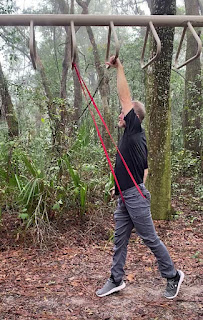Swinging from Monkey Bars Links the Muscles Involved with Side Bending and Rotation
You can see this on the image to the left. As I am directly below the bar, the myofascia (muscles and fascia) along the right side of my torso is lengthening and supporting. This builds energy in the channel as the tissue builds elastic length. First off, this can be somewhat stressful for this tissue if you have not prepared the body with proper warm ups, joint preparation and if you do not have a baseline of pulling strength. Be careful and take you time building strength and resilience!
Once these conditions are met, you want the energy that is built from the lengthened myofascia to recoil and propel you through the rest of the move. This is a theme we see though much of the Gallbladder sinew channel and it is also active in the similar movement of walking and running as the IT Band stretches and recoils, propelling the body into the next phase of gait and conserving energy in the process.
The other thing to notice is that as I am reaching my left arm out, I am bringing my right hip and thigh forward. This opposite arm and thigh means that I am rotating the torso or ribcage on the pelvis. The right internal obliques and the left external obliques are shortening to drive this motion. As I continue through with the swing, the entire right side (both obliques and lats) will shorten. All of this drives me forward to the next bar.
Swinging Progressions
There are many progression to build strength and elasticity of the myofascial plane of the Gallbladder sinew channel which will prevent injury. I recommend starting with resistance bands. This progression requires working with one side at a time and then you will switch and perform the same progression on the next side. You attach the band to the bar you are skipping and loop the band secure into the groin. This might be obvious, but you want to be careful that the band is secure between the genitals and the adductor tendons since you definitely would not want to support your weight into a band that is pressing into the genitals. Once the bands is in place, however, it will not cause any problems.
You will them bring the thigh back into extension on the same side as the arm that is holding the bar. As you swing and reach, the band will be fully lengthened when you are directly under it and it will therefore be supports some of your body weight. You need to pick a band thickness that is appropriate for your level.
The band then assists you as you contract the muscles of the Gallbladder sinew channel which shorten the side and counter-rotate the ribcage and pelvis. The band matches the elasticity of the Gallbladder sinew channel. It is maximally stretched as you are directly under your hand and then it recoils and propels you through the move.









No comments:
Post a Comment